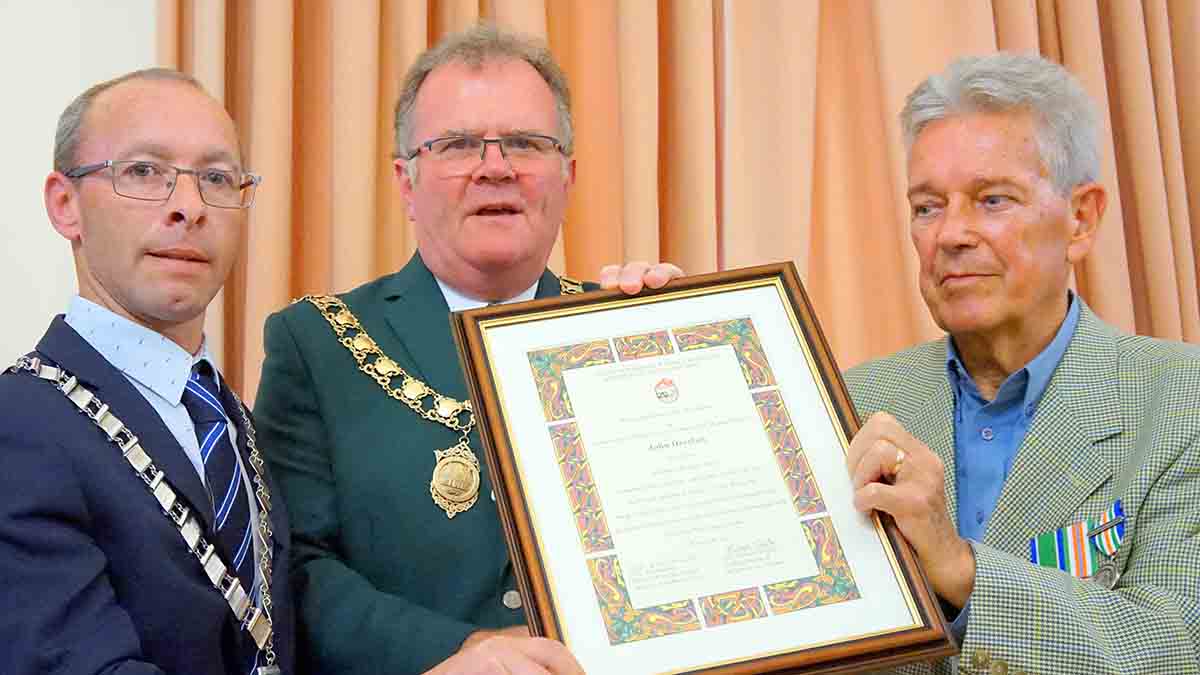Tuesday, 24th. October, 2023 is international United Nations Day, celebrated worldwide
On a recent visit to Kilkenny’s City Hall, at the invitation of Mayor Joe Malone, Commandant Leo Quinlan delivered an exhilarating talk on The siege of Jadotville in 1961.
On the night, Mayor Malone said that the story of the heroes of Jadotville were finally being recognised.
This week Leo Quinlan got in touch with The Kilkenny Observer with an update.
Martin O’Connor — the son of Corporal Tom O’Connor, a Siege of Jadotville veteran (Congo, Africa – 1961) — is invited to lay a wreath in Australia to honour Ireland’s men of Jadotville.
Ambassadors and dignitaries from many countries where United Nations troops served or are serving, together with Australian veterans’ groups, will be in attendance and, for the first time, Ireland, by virtue of the Siege of Jadotville by UN peacekeeping members of the Irish Defence Forces, will be honoured.
It is worth mentioning the ages of the men in the Siege of Jadotville.
• Two mothers of sons fighting in Jadotville on DAY 3 of the battle (Wednesday, 13th. September to Sunday, 17th. September, 1961) collected the Children’s Allowance payments for these sons in the post office back home in Athlone, Ireland.
• These two boys were only 15 years old.
• Approximately 13 of these men in the Siege of Jadotville were only 16 years old — some of them celebrated their 17th, birthdays as Prisoners of War in the Congo, Africa.
• The average age of the men of Jadotville was 18.5 years old.
On DAY 3 of the battle the media reported all the Irish soldiers had been killed in Jadotville, which left families in Ireland mourning their dead for two days.
One media report stated as fact that all 155 Irish soldiers were dead and that all the Irish Army officers had been executed by firing squad.
On DAY 5 it was confirmed that all 155 men were alive, albeit with five men wounded.
These were the 155 boys/men who fought an overwhelming enemy force of some 3,000, led by battle hardened veterans of World War II, the Korean War, and many other conflicts.
These UN peacekeepers from Ireland successfully defended their positions in Jadotville for 5 days and night, until they ran out of ammunition, food and water.
They served as Prisoners of War in Congo for over a month, from Sunday, 17th. September, being released on Wednesday, 25th. October, 1961.
While Prisoners of War, messages/tape recordings were sent from families in Ireland to their Prisoners of War loved ones being held in Congo, and returning messages/tapes from the men arrived back to the families a few weeks later – all of which provided comfort to families who were anxious about the safety of their men.
Thankfully, in December, 1961 all men of this Irish Company — A Company, 35th. Irish Infantry Battalion, ONUC (United Nations Operation in the Congo) — arrived home safely to Ireland, where civic receptions were held for them in every town and village where they were born and lived.
The men in the Siege of Jadotville were led by Commandant (Major) Pat Quinlan, later Colonel.
The exploits of these men resulted in 34 of them being recommended for medals for leadership and courage – two of those recommended were only 16 years old.
These medals have yet to be awarded and a campaign is ongoing to address this situation.
The downside of this action in Jadotville, Congo is that many veterans suffered what is now recognised as Moral Injury, as a consequence of being ignored and betrayed by higher authority on their return to Ireland.
This situation for many of the men resulted in them suffering from mental anguish, alcohol abuse, broken relationships, depression and, in some cases, suicide.
The after-effects of Jadotville still resonate today among the three generations that have followed from 1961.
This battle, as depicted in books, radio and TV documentaries and a NETFLIX movie, tells the story of the largest battle the Irish Army has been involved in alone against a superior foreign enemy since the formation of the Irish State (1922).
This defensive action is recognised in military circles internationally as the epitome of a perfect perimeter defence, where 155 Irishmen survived attack by a 20 times stronger force without suffering any deaths while inflicting significant fatalities on the opposing force.




















